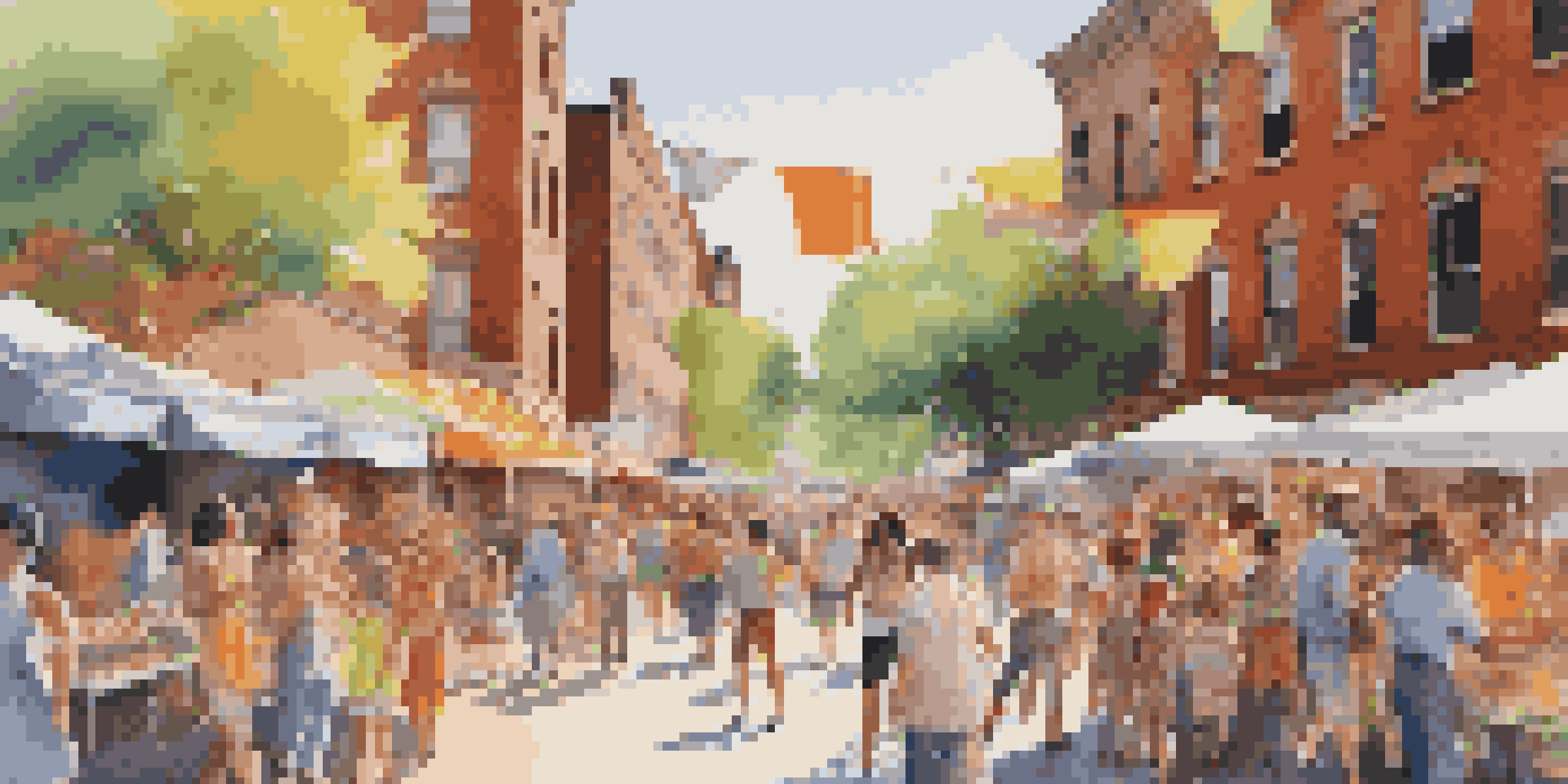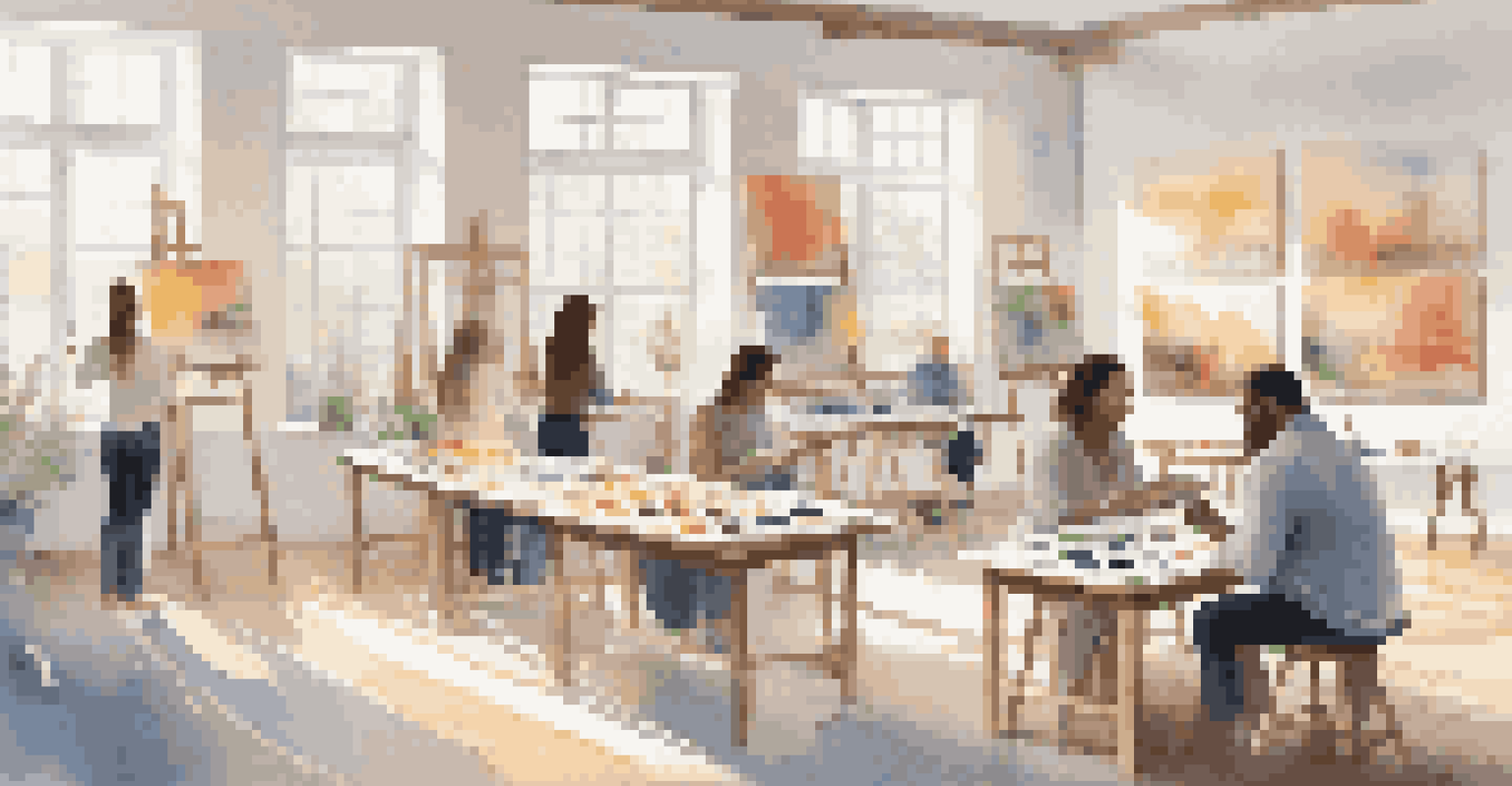Art as a Reflection of Societal Changes and Movements

Art as a Historical Mirror: Reflecting Change Over Time
Throughout history, art has served as a mirror to societal changes, capturing the spirit of a particular era. For instance, the tumultuous periods of the Renaissance and Baroque movements showcased shifting philosophies and cultural transformations. Artists like Michelangelo and Caravaggio not only created stunning visuals but also commented on the societal issues of their time, such as religion and humanism. This relationship between art and society allows us to understand the historical context behind each piece, making art a powerful tool for reflection.
Art is not freedom from discipline, but disciplined freedom.
As we move into the modern era, we see how movements such as Impressionism and Expressionism responded to rapid industrialization and urbanization. These art forms broke away from traditional techniques, mirroring the chaos and excitement of life in a bustling city. The brush strokes of Van Gogh or the color palettes of Matisse invite viewers to feel the emotional weight of their surroundings, emphasizing personal experience over realistic representation. It's fascinating how these changes in artistic expression resonate with the evolving human experience.
In essence, art not only documents history but also acts as a catalyst for change. It encourages conversations about social issues, prompting society to reflect and evolve. By examining art through the lens of the times it was created, we gain insight into the struggles and triumphs of humanity, making it a vital part of our cultural heritage.
The Impact of Social Movements on Artistic Expression
Social movements have historically shaped the artistic landscape, as artists frequently respond to the issues surrounding them. For example, the Harlem Renaissance in the 1920s was a significant cultural moment that highlighted African American identity through literature, music, and visual art. Artists like Jacob Lawrence and Zora Neale Hurston used their crafts to challenge racial stereotypes and celebrate Black culture, creating a powerful narrative that remains influential today.

Similarly, the feminist movement of the 1960s and 70s brought forth a wave of female artists who sought to redefine womanhood and challenge patriarchal norms. Artists like Judy Chicago and Cindy Sherman used their work to address gender roles and societal expectations, empowering women through their art. This shift not only expanded the definition of art but also opened doors for marginalized voices to be heard, illustrating how social movements can inspire profound change in artistic expression.
Art Reflects Societal Change
Throughout history, art has mirrored societal transformations, capturing the essence of different eras and prompting reflection on historical contexts.
As we explore these connections, it becomes clear that art is a vehicle for activism. It fosters awareness and encourages dialogue about pressing societal issues. By examining the impact of social movements on art, we can appreciate how creativity becomes a form of resistance and a means of empowerment for communities striving for change.
Art and Political Commentary: A Powerful Duo
Art has long served as a platform for political commentary, allowing artists to voice their opinions and critique societal norms. From Picasso's 'Guernica,' which captures the horrors of war, to Banksy's provocative street art, artists have used their work to respond to political events and injustices. This fusion of art and politics not only captures the emotions of the moment but also stimulates discussion and raises awareness among the public.
Every artist dips his brush in his own soul, and paints his own nature into his pictures.
One of the most striking examples of political art is the rise of protest art during the Civil Rights Movement. Artists like Faith Ringgold and Charles White addressed racial inequality and injustice through powerful imagery and themes. Their work not only documented the struggle but also served as a rallying cry for change, making art an integral part of the fight for civil rights. It’s a testament to how art can transcend mere aesthetics and become a powerful tool for social justice.
In contemporary society, we continue to see art as a form of resistance. Artists globally tackle issues like climate change, immigration, and systemic inequality, using their platforms to inspire action and provoke thought. This ongoing dialogue between art and politics reinforces the idea that art is not just a reflection of society but a catalyst for societal change.
The Role of Technology in Shaping Modern Art Movements
With the advent of technology, the art world has experienced a transformative shift, opening new avenues for expression and connection. Digital art, for instance, has emerged as a prominent form, allowing artists to experiment with tools that were once unimaginable. The use of software and digital platforms has democratized art creation, making it accessible to a broader audience and allowing for innovative collaborations across disciplines.
Moreover, technology has altered how we consume art. Social media platforms like Instagram and Pinterest enable artists to share their work instantly with a global audience, breaking down geographical boundaries. This shift in accessibility has fostered new art movements, such as meme art and digital installation, which reflect contemporary culture and the rapid pace of modern life. These movements capture the zeitgeist of our digital age, showcasing the interplay between technology and artistic expression.
Art as a Catalyst for Activism
Social movements have significantly influenced artistic expression, empowering artists to address pressing societal issues and promote change through their work.
As we navigate this tech-driven landscape, it's essential to recognize the implications of these changes on society. Art created in this context often addresses themes of identity, surveillance, and the impact of technology on human interaction. By embracing these new mediums, artists are not only reflecting societal changes but also shaping our understanding of what art can be in the 21st century.
Art as a Means of Healing and Social Change
Art has a remarkable ability to heal and bring about social change, providing a space for expression and reflection. Therapeutic art practices, such as art therapy, have been shown to help individuals cope with trauma and mental health issues. By engaging in the creative process, people can explore their feelings, find solace, and ultimately pave the way for personal healing—all of which speaks to art's transformative power.
In addition to individual healing, art can unite communities and foster social change. Projects like the
and community murals have been instrumental in addressing social issues and bringing people together. These collaborative efforts empower individuals to share their stories and experiences, creating a sense of belonging and solidarity. By harnessing the power of art, communities can challenge injustices and initiate meaningful dialogue.
This intersection of art, healing, and activism highlights its role as a force for positive change in society. Whether through individual expression or collective action, art serves as a reminder that creativity can inspire hope and foster resilience in the face of adversity. As we continue to explore these themes, we can appreciate the profound impact art has on both personal and societal levels.
Global Perspectives: Art from Diverse Cultures and Its Influence
Art serves as a global language, transcending cultural boundaries and offering a glimpse into diverse perspectives. Indigenous art forms, for example, convey rich histories and traditions, reflecting the values and experiences of their communities. By appreciating art from various cultures, we gain insight into the social structures, beliefs, and struggles that shape different societies, fostering a greater understanding of our shared humanity.
Moreover, the global exchange of artistic ideas has led to the emergence of hybrid forms that challenge traditional norms. Artists like Ai Weiwei and Yoko Ono draw inspiration from their cultural backgrounds while addressing universal themes, such as freedom and identity. This blending of influences enriches the art world, encouraging dialogue and collaboration among artists from different backgrounds, ultimately fostering a sense of unity.
Technology Shapes Modern Art
The rise of technology has transformed the art world, enabling new forms of expression and broadening access while reflecting contemporary cultural shifts.
As we navigate an increasingly interconnected world, it's essential to recognize the importance of diverse artistic voices. By amplifying these perspectives, we not only honor the complexity of human experience but also create spaces for empathy and understanding. Art becomes a powerful tool for bridging cultural divides, reminding us of the beauty found in our differences.
The Future of Art: Emerging Trends and Societal Reflections
As we look toward the future, emerging trends in art continue to reflect the shifting landscape of society. The rise of eco-art, for instance, addresses the pressing issue of climate change, encouraging artists to engage with environmental themes. Through installations and performances, artists like Olafur Eliasson and Agnes Meyer-Brandis challenge viewers to reconsider their relationship with nature and the impact of human actions on the planet.
Additionally, the integration of artificial intelligence and virtual reality into art is reshaping the creative process. These technologies not only enhance artistic expression but also prompt discussions about authenticity, creativity, and the role of the artist. As we embrace these advancements, we must reflect on how they influence our understanding of art and its relationship with society.

Ultimately, the future of art lies in its ability to adapt and respond to the evolving needs of society. By remaining attuned to the changing landscape, artists can continue to create works that resonate with audiences and inspire change. As we move forward, art will undoubtedly play a crucial role in shaping our collective consciousness and reflecting the complexities of the world around us.